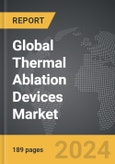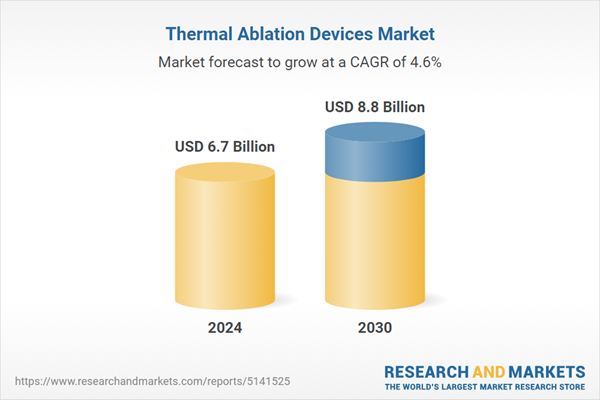The global market for Thermal Ablation Devices was valued at US$6.7 Billion in 2024 and is projected to reach US$8.8 Billion by 2030, growing at a CAGR of 4.6% from 2024 to 2030. This comprehensive report provides an in-depth analysis of market trends, drivers, and forecasts, helping you make informed business decisions. The report includes the most recent global tariff developments and how they impact the Thermal Ablation Devices market.
Segments: Component (Probes, Systems); End-Use (Hospitals, Ambulatory Surgery Centers, Clinics).
Geographic Regions/Countries: World; United States; Canada; Japan; China; Europe (France; Germany; Italy; United Kingdom; Spain; Russia; and Rest of Europe); Asia-Pacific (Australia; India; South Korea; and Rest of Asia-Pacific); Latin America (Argentina; Brazil; Mexico; and Rest of Latin America); Middle East (Iran; Israel; Saudi Arabia; United Arab Emirates; and Rest of Middle East); and Africa.
The analysts continuously track trade developments worldwide, drawing insights from leading global economists and over 200 industry and policy institutions, including think tanks, trade organizations, and national economic advisory bodies. This intelligence is integrated into forecasting models to provide timely, data-driven analysis of emerging risks and opportunities.
Global Thermal Ablation Devices Market - Key Trends and Drivers Summarized
Why Are Thermal Ablation Devices Becoming a Preferred Treatment Option?
Thermal ablation devices, which use heat to destroy abnormal tissues, have gained prominence as a minimally invasive treatment option for conditions such as cancer, cardiac arrhythmias, and chronic pain. The growing demand for non-invasive procedures has significantly boosted the adoption of these devices, particularly in oncology and cardiology. With patients increasingly seeking treatments that offer faster recovery times and fewer complications, thermal ablation has emerged as a viable alternative to traditional surgery. Moreover, technological advancements in microwave, radiofrequency, and laser-based ablation systems have enhanced the precision and effectiveness of these devices, making them more popular among healthcare providers.What Role Do Segments and End-Use Applications Play in the Market?
The thermal ablation devices market is divided into various segments based on technology, application, and end-users. In terms of technology, microwave and radiofrequency ablation devices dominate the market, with radiofrequency ablation being widely used for treating liver, lung, and kidney tumors. The application segments are primarily driven by oncology, where thermal ablation is used to treat solid tumors, and cardiology, where it is employed to manage arrhythmias such as atrial fibrillation. Other significant applications include pain management and gynecology. End-users in this market include hospitals, specialty clinics, and ambulatory surgical centers, with hospitals holding the largest share due to the growing number of outpatient procedures involving ablation devices.What Technological Innovations Are Transforming Thermal Ablation Devices?
Technological advancements are playing a pivotal role in the evolution of thermal ablation devices. Innovations such as real-time image guidance, improved energy delivery mechanisms, and the integration of robotics are driving the development of more precise and effective ablation systems. For instance, the use of advanced imaging technologies such as MRI and CT scans during ablation procedures allows for greater accuracy in targeting and treating tumors or abnormal tissues. Additionally, the integration of AI and machine learning is enabling physicians to optimize treatment protocols and improve patient outcomes. The development of portable ablation systems is another trend that is making these treatments more accessible in outpatient settings, expanding the market further.What Are the Main Growth Drivers in the Thermal Ablation Devices Market?
The growth in the thermal ablation devices market is driven by several factors, including the rising prevalence of cancer and cardiovascular diseases, the growing demand for minimally invasive treatments, and the increasing adoption of advanced ablation technologies. The expansion of outpatient surgical procedures, particularly in oncology and cardiology, is also contributing to market growth. Additionally, advancements in imaging and real-time monitoring technologies have improved the efficacy of thermal ablation treatments, which is driving adoption among healthcare providers. Regulatory approvals for new and innovative ablation devices are further boosting market growth. Moreover, increasing awareness about the benefits of non-invasive procedures and the reduction in healthcare costs associated with shorter hospital stays are key factors propelling market expansion.Report Scope
The report analyzes the Thermal Ablation Devices market, presented in terms of units. The analysis covers the key segments and geographic regions outlined below.Segments: Component (Probes, Systems); End-Use (Hospitals, Ambulatory Surgery Centers, Clinics).
Geographic Regions/Countries: World; United States; Canada; Japan; China; Europe (France; Germany; Italy; United Kingdom; Spain; Russia; and Rest of Europe); Asia-Pacific (Australia; India; South Korea; and Rest of Asia-Pacific); Latin America (Argentina; Brazil; Mexico; and Rest of Latin America); Middle East (Iran; Israel; Saudi Arabia; United Arab Emirates; and Rest of Middle East); and Africa.
Key Insights:
- Market Growth: Understand the significant growth trajectory of the Probes segment, which is expected to reach US$4.9 Billion by 2030 with a CAGR of a 5.2%. The Systems segment is also set to grow at 3.9% CAGR over the analysis period.
- Regional Analysis: Gain insights into the U.S. market, valued at $1.8 Billion in 2024, and China, forecasted to grow at an impressive 8.2% CAGR to reach $2.0 Billion by 2030. Discover growth trends in other key regions, including Japan, Canada, Germany, and the Asia-Pacific.
Why You Should Buy This Report:
- Detailed Market Analysis: Access a thorough analysis of the Global Thermal Ablation Devices Market, covering all major geographic regions and market segments.
- Competitive Insights: Get an overview of the competitive landscape, including the market presence of major players across different geographies.
- Future Trends and Drivers: Understand the key trends and drivers shaping the future of the Global Thermal Ablation Devices Market.
- Actionable Insights: Benefit from actionable insights that can help you identify new revenue opportunities and make strategic business decisions.
Key Questions Answered:
- How is the Global Thermal Ablation Devices Market expected to evolve by 2030?
- What are the main drivers and restraints affecting the market?
- Which market segments will grow the most over the forecast period?
- How will market shares for different regions and segments change by 2030?
- Who are the leading players in the market, and what are their prospects?
Report Features:
- Comprehensive Market Data: Independent analysis of annual sales and market forecasts in US$ Million from 2024 to 2030.
- In-Depth Regional Analysis: Detailed insights into key markets, including the U.S., China, Japan, Canada, Europe, Asia-Pacific, Latin America, Middle East, and Africa.
- Company Profiles: Coverage of players such as Abbott Laboratories, Inc., AngioDynamics, Inc., AtriCure, Inc., Boston Scientific Corporation, Halyard Health, Inc. and more.
- Complimentary Updates: Receive free report updates for one year to keep you informed of the latest market developments.
Some of the 31 companies featured in this Thermal Ablation Devices market report include:
- Abbott Laboratories, Inc.
- AngioDynamics, Inc.
- AtriCure, Inc.
- Boston Scientific Corporation
- Halyard Health, Inc.
- Hologic, Inc.
- Johnson & Johnson
- Medtronic PLC
- Olympus Corporation
- Smith & Nephew PLC
- Stryker Corporation
Tariff Impact Analysis: Key Insights for 2025
Global tariff negotiations across 180+ countries are reshaping supply chains, costs, and competitiveness. This report reflects the latest developments as of April 2025 and incorporates forward-looking insights into the market outlook.The analysts continuously track trade developments worldwide, drawing insights from leading global economists and over 200 industry and policy institutions, including think tanks, trade organizations, and national economic advisory bodies. This intelligence is integrated into forecasting models to provide timely, data-driven analysis of emerging risks and opportunities.
What’s Included in This Edition:
- Tariff-adjusted market forecasts by region and segment
- Analysis of cost and supply chain implications by sourcing and trade exposure
- Strategic insights into geographic shifts
Buyers receive a free July 2025 update with:
- Finalized tariff impacts and new trade agreement effects
- Updated projections reflecting global sourcing and cost shifts
- Expanded country-specific coverage across the industry
Table of Contents
I. METHODOLOGYII. EXECUTIVE SUMMARY2. FOCUS ON SELECT PLAYERSIII. MARKET ANALYSISSOUTH KOREAREST OF ASIA-PACIFICARGENTINABRAZILMEXICOREST OF LATIN AMERICAIRANISRAELSAUDI ARABIAUNITED ARAB EMIRATESREST OF MIDDLE EASTIV. COMPETITION
1. MARKET OVERVIEW
3. MARKET TRENDS & DRIVERS
4. GLOBAL MARKET PERSPECTIVE
UNITED STATES
CANADA
JAPAN
CHINA
EUROPE
FRANCE
GERMANY
ITALY
UNITED KINGDOM
SPAIN
RUSSIA
REST OF EUROPE
ASIA-PACIFIC
AUSTRALIA
INDIA
LATIN AMERICA
MIDDLE EAST
AFRICA
Companies Mentioned (Partial List)
A selection of companies mentioned in this report includes, but is not limited to:
- Abbott Laboratories, Inc.
- AngioDynamics, Inc.
- AtriCure, Inc.
- Boston Scientific Corporation
- Halyard Health, Inc.
- Hologic, Inc.
- Johnson & Johnson
- Medtronic PLC
- Olympus Corporation
- Smith & Nephew PLC
- Stryker Corporation
Table Information
| Report Attribute | Details |
|---|---|
| No. of Pages | 189 |
| Published | April 2025 |
| Forecast Period | 2024 - 2030 |
| Estimated Market Value ( USD | $ 6.7 Billion |
| Forecasted Market Value ( USD | $ 8.8 Billion |
| Compound Annual Growth Rate | 4.6% |
| Regions Covered | Global |









